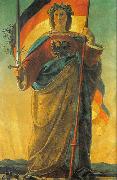Wholesale Oil Painting No Minimum |
|||||||||||
|
|
|||||||||||

|
|||||||||||
|
|
|
||||||||
Philipp veit1793 - 1877) was a German Romantic painter.German painter. The stepson, from 1804, of Friedrich von Schlegel, he studied (1808-11) at the Akademie in Dresden under Friedrich Matth?i (1777-1845) and Caspar David Friedrich. He showed talent in drawing but, on moving to Vienna in 1811, had difficulties with painting in oil, and turned to watercolour. Through Schlegel, Veit came to know many of the leading Romantics in Vienna, such as the poet and novelist Joseph von Eichendorff. In 1813-14 Veit took part in the campaign against Napoleon and returned briefly to Berlin. In 1815 he completed a votive picture, the Virgin with Christ and St John, for the church of St James in Heiligenstadt, Vienna (in situ), inspired by the work of Pietro Perugino and Raphael. In 1815 Veit left for Italy where he stayed until 1830. In Rome he joined the circle around Friedrich Overbeck and Peter Cornelius, becoming a leading Nazarene (see NAZARENES). With these artists he took part in providing fresco decorations (1816-17) for the Casa Bartholdy (now the Bibliotheca Hertziana): Veit painted the scene of Joseph and Potiphar's Wife and a decorative lunette allegory, the Seven Years of Plenty (both now Berlin, Staatl. Mussen, N.G.). In 1818 Veit was commissioned to paint the fresco of the Triumph of Religion in the Museo Chiaramonti in the Vatican, one of a series of murals recording the services of Pope Pius VII to science and art. |
||||||||
|
|
||||||||
wall fresco, St. Pauls Church
wall fresco, St. Pauls Church Painting ID:: 93653 |
Date 1848
wall fresco, St. Pauls Church, Frankfurt am Main, designed to cover the organ during the Frankfurt Assembly/Parliament, 1848-49
TTD Date 1848 wall fresco, St. Pauls Church, Frankfurt am Main, designed to cover the organ during the Frankfurt Assembly/Parliament, 1848-49 TTD |
|||||||
|
CONTACT US |

